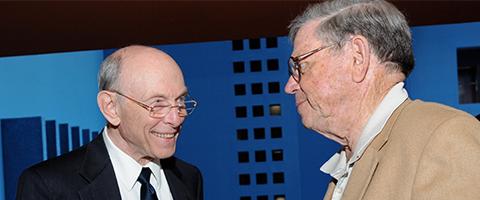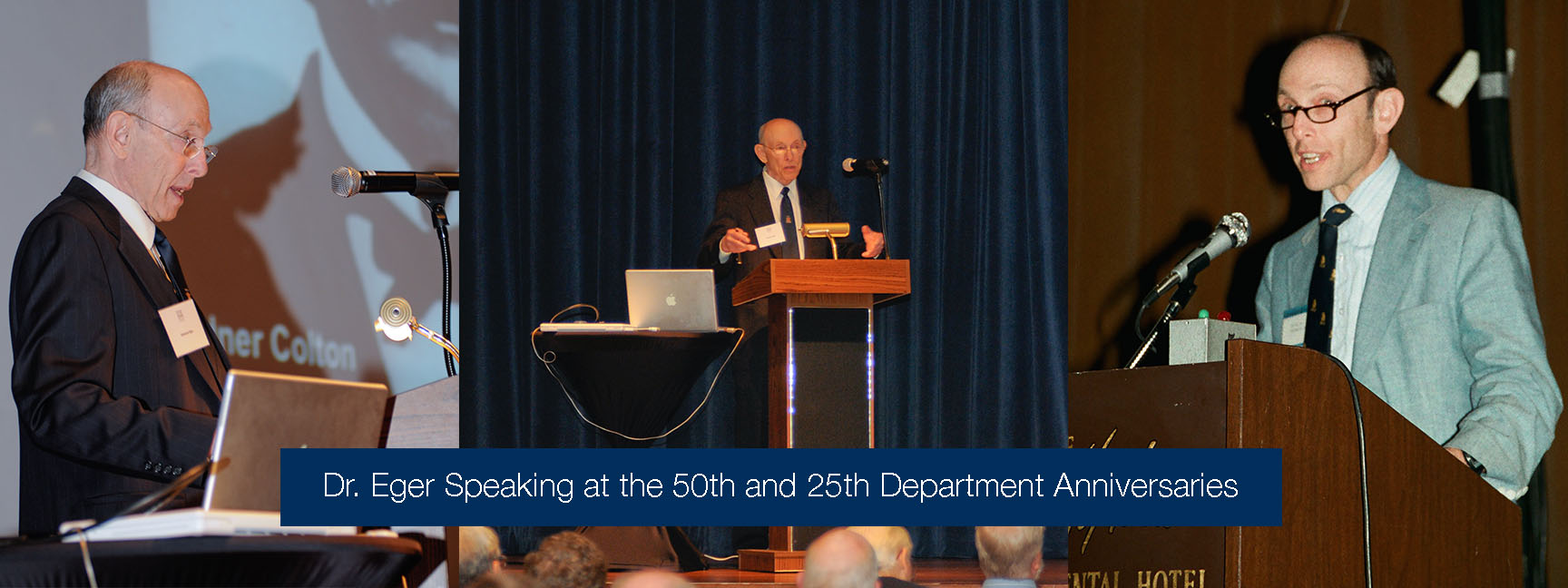
Dr. Edmond “Ted” Eger II, the anesthesiologist and scientist who pioneered development of modern inhaled anesthetics, died peacefully at his home in Tiburon, California, on August 26, 2017, one week shy of his 87th birthday. Dr. Eger’s research is the basis for the safe use of modern inhaled anesthetics administered to more than 300 million patients every year. His death was due to pancreatic cancer.
Working at the University of California, San Francisco, Dr. Eger methodically characterized the effects of drugs used in anesthetic practice. This work began with halothane and methoxyflurane in the 1960s and extended to enflurane and isoflurane in the 1970s, and to desflurane in the 1990s. Early in his career, Dr. Eger recognized the need for a fundamental unit of anesthetic potency, and introduced the concept of “MAC” for “minimum alveolar concentration” of anesthetic required to prevent movement in patients in response to surgery. MAC provided an immensely powerful research and clinical tool and became a standard for all studies of anesthetic action. It remains the standard dosing unit used by practicing anesthesiologists to this day. Dr. Eger also identified the processes governing the onset, uptake, and distribution of inhaled anesthetics into the lungs and body tissues, including the brain, and how quickly anesthetics are removed at the end of anesthesia. This provided precise guidance on how to administer inhaled anesthetics safely and effectively during surgery. Dr. Eger developed these concepts for the anesthetics available in the 1960s, and then used these concepts to identify new drugs meriting commercial development: isoflurane, sevoflurane, and desflurane. These three drugs are the mainstays of modern anesthetic practice.
Edmond I Eger II was born Sept. 3, 1930, in Chicago, the son of an advertising executive. The young Ted Eger received ether anesthesia at ages 6 and 10, experiences that would haunt him and guide him into a career to improve anesthesia care. In both cases, he felt restrained, suffocated, and drawn into a black vortex as consciousness disappeared.

Dr. Eger graduated from Hyde Park High School at the age of 15, having led his school checker team to two consecutive victories in the All-Chicago Checker Championship. He graduated in the lower 20 percent of the class, however, and after his first (and only) day of selling women’s shoes, he resolved to improve his study habits. He enrolled in Roosevelt College and was able to transfer to the University of Illinois one year later, from which he graduated Phi Beta Kappa with a major in chemistry and a minor in mathematics. Later that year, he enrolled in Northwestern Medical School, from which he graduated in 1955. He had expected to pursue a career as a general internist, when an epiphany during an externship directed him to a career in anesthesia instead: assisting with the care of a patient receiving the anesthetic thiopental by infusion, the patient’s breathing gradually slowed and finally stopped, whereupon Eger discovered that he could move air in and out of the patient’s lungs by squeezing the anesthesia breathing bag, thus keeping him alive. This power of controlling a person’s breathing with his hands, coupled with the haunting memory of his own sense of suffocation during anesthesia, inspired him to embark on a career in anesthesiology. He was determined to improve on what he had experienced as a child.
Following a one-year internship at St. Luke’s Hospital in Chicago, Dr. Eger began residency training at the University of Iowa with a new baby and wife, Dollie Ross Eger, in tow (after 25 years of marriage, they divorced in 1983). Under the leadership of Iowa’s Dr. Stuart Cullen, Dr. Eger began publishing his first research papers and also began working with another anesthesia resident, Dr. John Severinghaus, who successfully challenged Dr. Eger’s initial notions about the physiology of uptake and distribution. Dr. Eger followed him to UCSF to work as his research fellow and spent the next 50 years applying precise mathematical detail to answer the questions that Dr. Severinghaus had posed while they were residents.

 Dr. Eger’s research, with numerous collaborators, led to more than 500 peer-reviewed publications, including nine of the 100 most highly cited anesthesia-related publications. His research trainees include the editors-in-chief of Anesthesiology and Anesthesia and Analgesia; two medical school deans; four recipients of the Distinguished Service Award from the American Society of Anesthesiologists; four recipients of the Excellence in Research Award from the American Society of Anesthesiologists; and 24 chairs of departments of Anesthesiology. Dr. Eger has received numerous awards for his research and leadership roles in anesthesia, including the Distinguished Service Award and the Excellence in Research Award from the American Society of Anesthesiology, and is an Elected Fellow of the Royal College of Surgeons, London.
Dr. Eger’s research, with numerous collaborators, led to more than 500 peer-reviewed publications, including nine of the 100 most highly cited anesthesia-related publications. His research trainees include the editors-in-chief of Anesthesiology and Anesthesia and Analgesia; two medical school deans; four recipients of the Distinguished Service Award from the American Society of Anesthesiologists; four recipients of the Excellence in Research Award from the American Society of Anesthesiologists; and 24 chairs of departments of Anesthesiology. Dr. Eger has received numerous awards for his research and leadership roles in anesthesia, including the Distinguished Service Award and the Excellence in Research Award from the American Society of Anesthesiology, and is an Elected Fellow of the Royal College of Surgeons, London.

Dr. Eger is the author, co-author, or co-editor of seven books. The first, Anesthetic Uptake and Action, published in 1975, remains the definitive description of the principles of anesthetic pharmacology. The last, The Wondrous Story of Anesthesia, edited with Lawrence Saidman and Roderick Westhorpe, provides a definitive history.
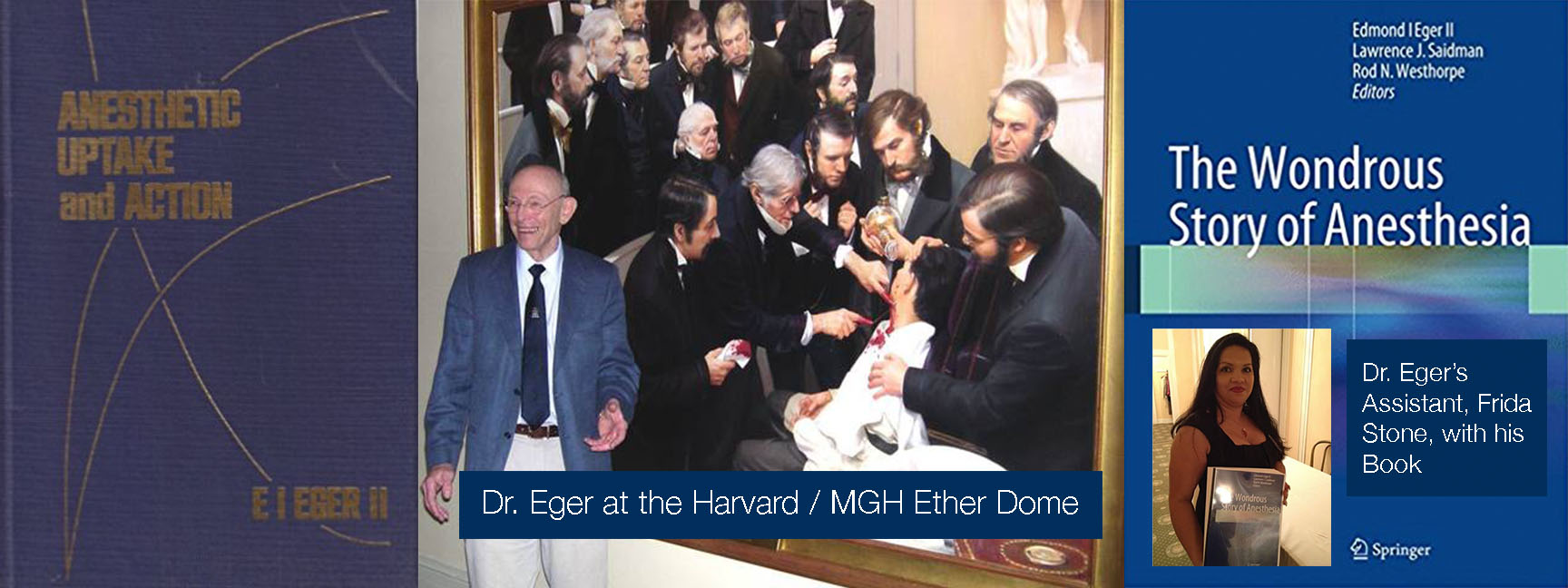
Fifty-five years ago, Dr. Eger founded and subsequently supported the Western Anesthesia Residents Conference, an annual meeting hosted by departments of anesthesia located in the western US inviting Anesthesia Residents to present results of their research. This Conference has thrived and grown over the years to a vibrant annual meeting well-attended by residents, department chairs, and anesthesia research faculty. The conference recently honored Dr. Eger by naming an annual lectureship after him.
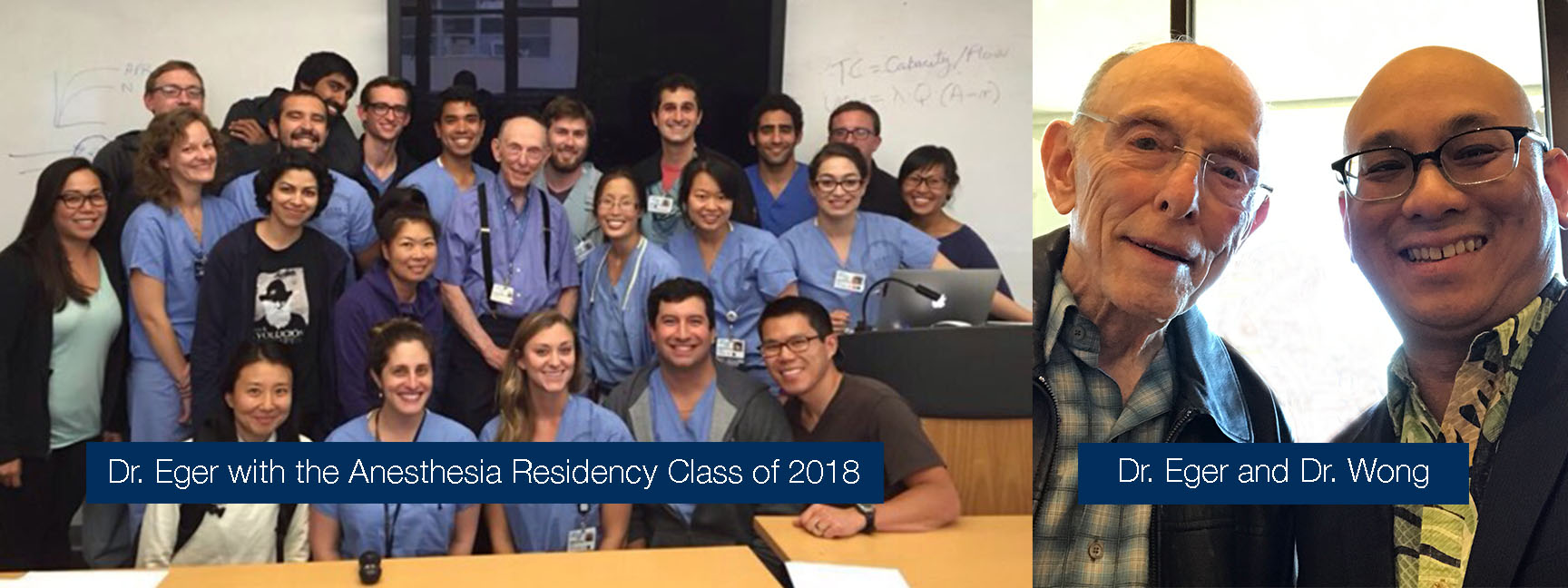
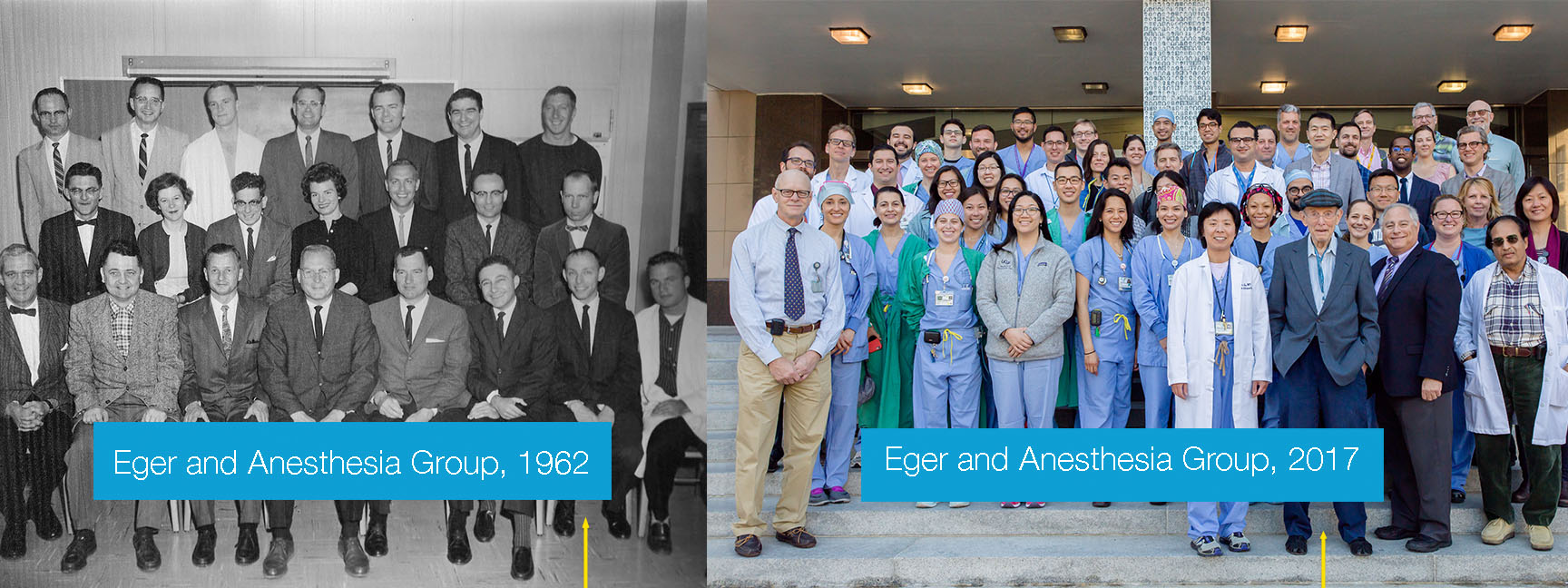
Dr. Eger spent his final two decades as an investigator pursuing an answer to how inhaled anesthetics work. This is one of the oldest mysteries in pharmacology, resisting solving by all of the tools of modern molecular biology. Dr. Eger discovered tantalizing clues about how fundamentally different various anesthetics are, while also proving that anesthetics have less person-to-person variability than do other drugs. He showed that modern inhaled anesthetics can anesthetize any animal at doses similar to those in humans, that plants and even the most primitive forms of life, blue-green algae, can be anesthetized. No other drug behaves like this. But despite these clues and decades of work, the puzzle of exactly how anesthetics work remains unsolved.
An avid lover of nature, Dr. Eger hiked throughout the Sierra Nevada and completed the entire John Muir Trail three times; one of his favorite places was Yosemite’s Half Dome, which he last climbed on his 75th birthday with his entire family. Dr. Eger is survived by his wife of 21 years, Dr. Lynn Spitler; four children, Cris Cadence Waste, Dr. Doreen J. Eger, Edmond Eger III, and Dr. Renee R. Eger; two step- children, Dr. Diane Anderson and Paul Spitler; seven grandchildren, six step-grandchildren, and a half- brother, Larry Eger.

Here are some remembrances we've received about Dr. Eger. We invite you to submit your reflections about Ted Eger, at: [email protected].
From Michael Bokoch, MD, PhD, Assistant Professor, UCSF Anesthesia and Perioperative Care, UCSF Anesthesia and Perioperative Care Residency Class of 2015
What a joy and inspiration to have met and learned from Dr. Eger - and had an oral board stem from him! Makes me feel lucky indeed to be part of this incredible UCSF family.
From Cindy Chin, UCSF Anesthesia and Perioperative Care Residency Coordinator
I would like to share this picture of Dr. Eger taken with his wife at the Class of 2011’s graduation party. I will miss him dearly!
From David J. Cullen MD, MS, Former Chair of Anesthesiology, Tufts University and St. Elizabeth’s Medical Center, UCSF Anesthesia Residency Class of 1969 (Chief Resident)
Ted Eger was the most influential, important, and substantive mentor in my entire lifetime of 77 years (so far).
As a medical student at the University of Michigan, 1961-65, I was initially curious about anesthesia when I learned a monograph had been written about anesthesiology by a man named Stuart Cullen. Having the same last name, but being unrelated (unlike my dear colleague, Bruce Cullen), I was intrigued and completed a one month anesthesia elective in my senior year which convinced me to pursue training in anesthesiology. During my residency interview in1964 with Dr. Robert Dripps, Department Chair at the University of Pennsylvania, he told me there were only 3 top departments in the country at that time; Penn, Columbia, and UCSF. Coming from Detroit, choosing San Francisco over Philadelphia and New York was an easy decision, and, most fortunately, led to my relationship with Ted Eger.
Starting residency in July, 1966, I soon realized what a remarkable training program I had entered because so much of the teaching, guidance and directed learning was based on the new discoveries establishing a scientific foundation for administering anesthesia more safely, led by Drs. Severinghaus and Eger. I developed an understanding of uptake and distribution, equipotency, and the early attempts to discern the mechanism/s by which anesthesia works. The technical skills, neat tricks, the art of the many facets of problem solving all were important too. But Ted’s work clearly led us to understand what every general anesthetic (almost always using one or another inhalation anesthetic) was based on; i.e. a far more fundamental and scientific basis which greatly enhanced our understanding of what we were doing to the “black box” that is the brain, about which so little was known at time.
Thus, I applied for, and was accepted as Ted’s research fellow for 1967-68 which also included full access to all the wonders of the Cardiovascular Research Institute, especially Dr. Severinghaus and his lab. I mention this because, with Ted’s guidance, mentorship, direction, leadership, and inspiration, I was able to develop research protocols which piqued my own interest and which he supported, such as the interaction between the inhalation anesthetics and hypoxia, hypo and hypercarbia, and severe anemia. In turn, I also participated fully in Ted’s pioneering and extraordinary studies of the many effects of inhalation anesthetics in human volunteers, conducted at UCSF, and with N. Ty Smith at Stanford. The level of technical sophistication used in these studies was so far beyond anything I could have imagined. Over time, many of these technical achievements have become clinical standards of care.
He taught me so much about data analysis and extracting relevant information from the literature. Importantly, he instilled in me the need for critical thinking, always questioning why we made the clinical decisions we made, and often asking me to justify, if I could, why I did what I did when he supervised my clinical work. There should be a justifiable answer for almost every detail involved in the choices one made to provide the safest and most effective anesthetic possible, given the circumstances. When no good answer could be provided, he prompted us to research the literature, or else to think about how to study the question. This approach served me well throughout my entire career.
To sum up, because of Ted’s influence, my learning curve soared that year beyond my wildest expectations, allowing me to continue research studies during my 3rd year of residency, and while in the Air Force for 2 years, and enabled my recruitment to Massachusetts General Hospital and Harvard Medical School as an academic anesthesiologist and critical care intensivist for many years. I have no doubt that my career would have been far less interesting and successful without the tools implanted in me by Ted Eger. I am sure the same can be said for every one of Ted’s fellows, let alone the innumerable residents he taught directly, and the worldwide influence his research, teaching and publications have had on our specialty. He truly was a giant in advancing our specialty and we were all so fortunate to live, work and thrive under his influence. In addition, he was a “mensch” of the highest order, a truly wonderful mentor, friend, and colleague. He will be sorely missed.
From Janet A. Dewan PhD, MS, CRNA, Associate Nurse Anesthesia Program Director, Northeastern University
I was fortunate to enjoy professional time and relaxed dinners with Dr Eger when he lectured at the AANA meetings. I have been quoting him, posting his articles, since 1981, when I first taught Uptake and Distribution of Inhaled Anesthetics to Nurse Anesthesia Students. Although I still reference him proudly in the inhalation anesthesia sequence, I now have added material from The Wondrous Story of Anesthesia to his influences, and use it in my History of Anesthesia lectures. His signed copy of that book is one of my anesthesia treasures.
Reading his work is enlightening on many levels but my lasting memory of his greatest influence on me as a teacher of anesthetists stems from a personal encounter a few years ago at a meeting. I saw what a spontaneously open to ideas scientist and human he was. I told Dr Eger that every year when my new graduate nursing students come to our program I ask, in the first class, that they all take out a piece of paper and write down how they think general anesthesia works. I end up with a variety of semi pharmacologic/physiologic explanations, and some more spiritual ones. I save these and at graduation time ask the students if their ideas have changed...emphasizing there is still a mystery. When I told this to Dr Eger I thought he might chuckle visualizing the beginning student attempt at expressing understanding of a phenomenon not completely explained. But , no he immediately and enthusiastically said "Oh keep doing that, one of them may have an insight that is needed. " I saw in him a man, who knows much more about the actions of anesthetics than I ever will, but who looked at every opportunity as one to uncover new ideas, even from beginning students who have never delivered an anesthetic.. I read my students' theories with a more open and inquisitive mind, now, because of his comment.
Thank you Dr Eger for making a complex topic understandable, for recognizing the vast continuum of knowledge, evidence and skill that has evolved into the anesthesia practice we have today, and for making us all see there are discoveries yet to come.
From Stuart Forman, MD, Professor of Anesthesia, Massachusetts General Hospital
In 2007, I had the honor of hosting Ted Eger at MGH as our Ether Day Grand Rounds speaker. Ted also insisted on delivering a second talk in the Ether Dome entitled “A Personal History of Anesthesia”, in which he described his professional journey and love for our clinical specialty and research to a rapt standing-room-only audience. The photo Steve included in his email (below) was taken in the Ether Dome at that event.
Upon receiving Steve’s email, I located my introductory comments for Ted’s Ether Dome talk. Here is the text of my comments as they related to Ted’s career, as of 2007:
Professor Edmond “Ted” Eger trained in Chicago and then served several years as a physician in the military before moving to San Francisco to pursue an Academic Anesthesiology career. Ted has made an astounding number of contributions to our understanding of anesthetic pharmacology during his more than four decades at UCSF. He literally “wrote the book” on anesthetic uptake and distribution. In 1965 Professor Eger and his colleagues at UCSF took a firm stand, defining a specific clinical endpoint, “lack of movement in response to a standard noxious stimulus,” and used this anchoring point to measure and compare the potency of various inhaled agents. “Minimal alveolar concentration” or “MAC” remains THE standard by which anesthetic potency is measured, and the stimulus-response paradigm has enriched our understanding of how to meaningfully measure anesthetic depth. Of course, Ted has not restricted his scholarship to the clinical actions of anesthetics. He has spearheaded investigations of anesthetic mechanisms, and he continues to lead a very productive Program Project Grant applying a systems neurobiology approach to the problem. Along the way, Ted has written numerous books, published over 500 peer reviewed papers, and created a legacy of trainees that include Lawrence Saidman, Robert Stoelting, Bruce Cullen, Michael Cahalan, and many other national and international leaders in Anesthesia research and education. The ASA has honored Ted with both the Excellence in Research Award and the Distinguished Service Award. He was elected Fellow to the Royal Colleges of Surgeons in both London and Ireland. And Ted, seemingly ageless, is still going strong, mentoring another generation of Academic Anesthesiologists.
From Claire Harmon, UCSF Anesthesia and Perioperative Care Research Administration Manager
My contact with Ted Eger consisted mostly of helping him and the team of investigators complete annual progress reports and renewal applications for his NIH program project grant, Sites and Mechanisms of Inhaled Anesthetic Actions. My boss and I also met regularly with Dr. Eger to go over the grant’s finances. It was in one of these meetings that I discovered that Dr. Eger and I had similar tastes in books. From that point until the grant ended several years later, he and I exchanged books regularly, and I always enjoyed our discussions about them. I appreciated that we were simply two enthusiasts.
From Brian Hite, MD, UCSF Anesthesia Residency Class of 2000
Yes. I think I did the last closed circuit anesthetic at Moffit with him in 1999-2000. He taught me old school anesthesia. I even mastered the inhaled desflurane induction. Yes, we will intubate the trachea and ventilate the patients lung with mechanical respirator
From Evan Koch, CRNA, MSN:
Ted Eger taught without ever intending to. He caused people to question things. He gently inspired people to reach beyond anything they ever thought could be accomplished. And Ted was ecumenical. “The Wondrous Story of Anesthesia” was the first history to include both CRNAs and anesthesiologists, Ted’s way of saying that both groups have been responsible for advancing the art and science of anesthesia. Ted was widely admired by CRNAs. He spoke at national and regional meetings many times. The American Association of Nurse Anesthetists presented Ted with its Public Service in Anesthesia Award for his good work, friendship, and honesty. Ted Eger was a true mentor to our entire profession, and he will be missed.
From Hannah Kwon, MD, UCSF Anesthesia and Perioperative Care Residency Class of 2009
Dr. Ted Eger...possibly one of the most memorable attendings during my residency training. Even at almost 80 years old (at the time), he continued to come into the ORs to teach us personally. I still remember his introductory lecture to us CA-1s about inhaled anesthetics and him speaking about how we uptake the inhaled agent through our lungs, it enters our circulation and then in our brains, and then "magic happens."
He pushed us all as first year anesthesia residents to do things we were uncomfortable with, to challenge us and show us the true limits of various anesthesia techniques.
I was just another resident in training there, but I feel so lucky to have experienced this GIANT and his love for teaching first hand. What an amazing man. RIP Dr. Eger.
From Esther Lee, MD, UCSF Anesthesia and Perioperative Care Residency Class of 2018
The UCSF Anesthesia Class of 2018 will always remember the wit, humor, tact and sharpness of Dr. Eger during his lectures on inhaled anesthetics. Forever grateful to have learned from one the greatest giants in anesthesia.
From Errol Lobo, MD, PhD, Professor, UCSF Anesthesia and Perioperative Care, UCSF Anesthesia and Perioperative Care Residency Class of 1992
When we come in as residents or new faculty, we are still impressionable, and most of us incorporate some of the traits (characteristics), some good of our attendings and mentors. In my third week as a resident at UCSF, Professor Eger was my attending. It was a time when all residents did their pre-ops as patients were usually admitted the night before their scheduled surgery. I had this one patient who was scheduled for a knee replacement, and when I attempted to do my pre-op, I encountered the surgical attending for the case. He did not like the fact that I had an afro and a beard, so as I entered the patient’s room, he berated me calling me the “N” word and more. As a new resident, I was traumatized and wanted nothing to do with the case. Even though Professor Eger may not have understood the implications of the ugly “N” word for me, he told me to raise my head up and never to submit to bullies and to give the best anesthetic of my young anesthetic career and he would be present every moment of the case. This event and Professor Eger’s response to it made me tougher and gave me more respect for my chosen specialty – anesthesiology. Professor Eger could have taken the easy route and got the assignment changed as most others would. I never did thank Dr. Eger, but I will never forget this event.
From Rachel McKay, MD, Professor, UCSF Anesthesia and Perioperative Care, UCSF Residency Class of 1998
Dr. Eger valued his interactions with motivated learners of all sorts (even faculty), but he especially enjoyed having the opportunity to teach and interact with the anesthesia residents.
I thought others might appreciate this transcript of the Second Annual John Severinghaus Lecture on Translational Science, given at the ASA in 2009. Although at the time everyone was aware of his resourcefulness, and significant contributions to the fields of anesthesia and surgery, honestly I was struck by his candor and introspection in describing his journey.
One of my favorite lines here: “Research should equal fun”. He reminded us about this from time to time, both in words and by example.
From Ronald D. Miller, MD, Professor Emeritus, UCSF Anesthesia and Perioperative Care, Chair, UCSF Anesthesia and Perioperative Care, 1984-2009
Ted Eger, Bill Hamilton and I lived near each other in Marin County. During the gasoline shortages in the l970s, we shared a ride to and from work at UCSF.
This means that the 3 of us had many lengthy conversations; I only wish those conversations had been recorded. I and we will miss them both.
From William North, CRNA
I met Dr Eger at Charity Hospital in New Orleans in 1983. He was a genius in his field.
From Steven L. Shafer, MD, Professor of Anesthesiology, Perioperative And Pain Medicine, Stanford University
Ted was among the leaders of a generation of clinical scientists who transformed our specialty from an art to a science. Some of this generation have passed. Some of this generation are still with us. Of those, some are even on this list! Thank you for your decades of work creating the scientific specialty of modern anesthesia.
We will miss Ted, the scientist, clinician, teacher, and friend.
Ted’s contributions will live on. Tomorrow, when you anesthetize your patient with isoflurane, sevoflurane (yes, sevoflurane), or desflurane, when you adjust the partial pressure to 1 MAC, when you use the principles of anesthetic uptake and distribution to awaken your patient, pause for a moment of joy that one of us, Ted Eger, contributed so much to the safety of our practice and wellbeing of our patients.
From Jenson Wong, MD, Associate Professor, UCSF Anesthesia and Perioperative Care, UCSF Anesthesia and Perioperative Care Residency Class of 2005
I was really sad and surprised to hear about Ted. I thought I’d share this selfie I took with him at graduation this year. I took the pic to share it with my mom, who knew Ted when she was working in Joan Kendig’s lab at Stanford in the 1990s and early 2000s.
From San Yuan, MD, UCSF Anesthesia and Perioperative Care Residency Class of 1988:
I am deeply sadden by this news; another giant of anesthesia has fallen! I still remember the night when we all went over to his house on Twin Peaks to discuss the Nitrous Oxide’s effect on methionine synthetase.True gentlemen and scholars are hard to come by nowadays. And Ted typifies that image.
From David Zvara, MD, Professor and Chair, University of North Carolina at Chapel Hill
Thank you for sending this. I knew Ted. He was a remarkable physician and colleague.
Click here to read his obituary published by the New York Times, "Dr. Edmond Eger II, 86, Dies; Found Way to Make Anesthesia Safer."
A memorial symposium, dedicated to Dr. Eger, will be held on February 02, 2018. Please keep an eye on our Anesthesia Events section for details.
Finally, we are hoping to raise funds in Dr. Eger’s name to encourage Anesthesia residents and fellows to pursue careers in research typified by his extraordinary success. To support this endeavor, please contact Allison White at [email protected] or 415.502.5868.
